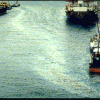On the afternoon of Thursday 28 July 1988, while berthing in Portland harbour, Victoria, the Kuwait-registered livestock carrier Al Qurain struck a wharf knuckle heavily and ruptured a ship's side fuel tank. An estimated 184 tonnes of bunker C fuel escaped into the harbour. The port authority boomed off the entrance using oil spill boom. Fortunately the wind also helped to keep the oil in the south-east corner of the harbour.

Photo: AMSA
Clean up operations commenced in earnest on the Friday morning and continued until the bulk of the oil was recovered on Monday 1 August. The Port Manager for the Portland Port Authority was the on scene coordinator, his team being made up of personnel from the Federal Department of Transport and Communications (now the Australian Maritime Safety Authority), the Port of Melbourne Authority and contractors. Equipment included a MARCO oil recovery vessel, skimmers and salvage pumps from a harbour tug.
The weather was cold, air temperature 12C (max) to 4C (min), and prevailing south-westerly winds with rain showers were typical of the winter conditions. During the day the oil was scarcely pumpable, at night it was solid.
Oil was recovered into a hopper barge from where it was pumped by a vacuum truck to a disused storage tank in a nearby oil terminal. Again, because of the low temperatures, some difficulty was experienced in emptying the vac truck. Diesel oil was subsequently used to cut the oil and make it more pumpable. A quantity of straw was used as a sorbent in the early stages of the spill before equipment arrived on scene. This subsequently proved to be a nuisance as it clogged recovery systems. In the later stages, polypropylene sorbents were used effectively.
Most of the oil impacted rock walls and penetrated under berths; no beaches were oiled. A fairy penguin rookery exists within the harbour area but the oil was prevented from getting into this area. Although six penguins were oiled no mortalities were reported.
During the latter stages of the clean up, a high pressure water jet system was brought from Melbourne. This was used effectively to clean rock wall faces.
Outcome
Although the major part of the clean-up was achieved in four days during which time approximately 175 tonnes of oil was recovered, final clean up was not completed until September 1989 due to the viscous oil lodging under wharves and escaping as the weather warmed up.
The vessel's Protection and Indemnity Club accepted a letter of undertaking to consider a claim. Clean up costs incurred by the port authority were in the vicinity of A$776,000.
Related information
Read about Australia's National Plan for Maritime Environmental Emergencies.